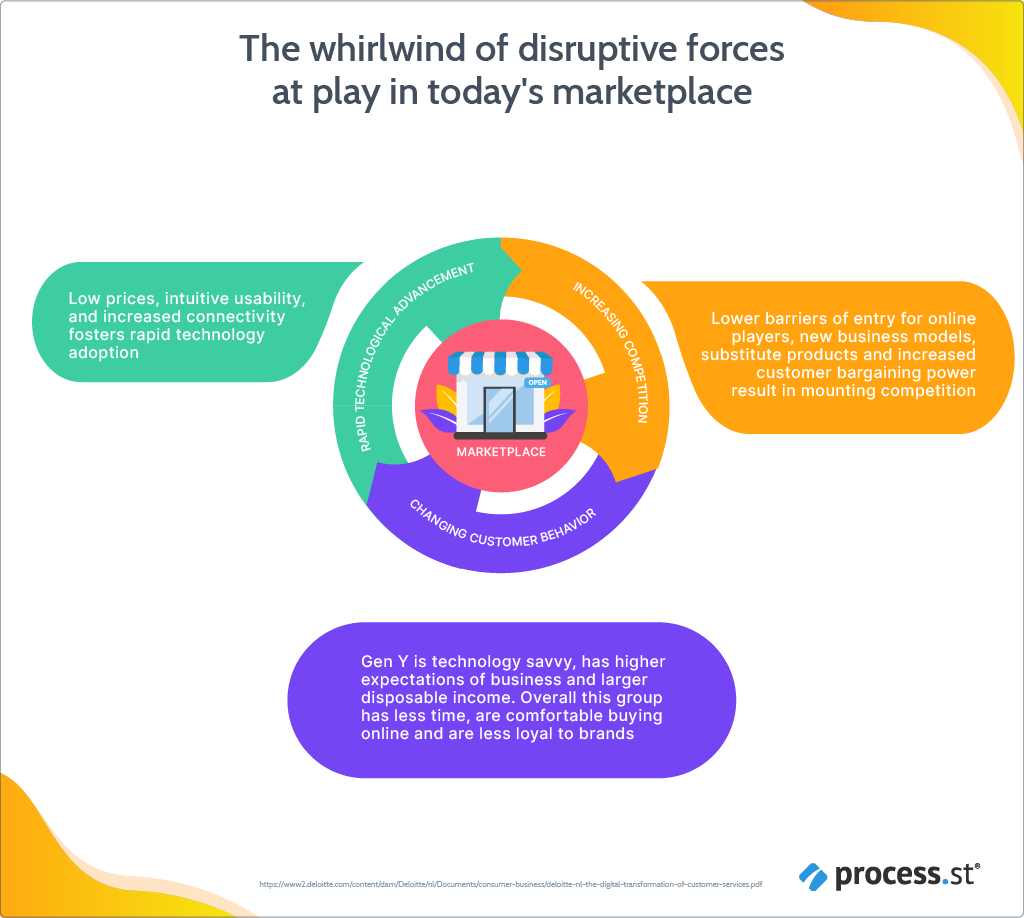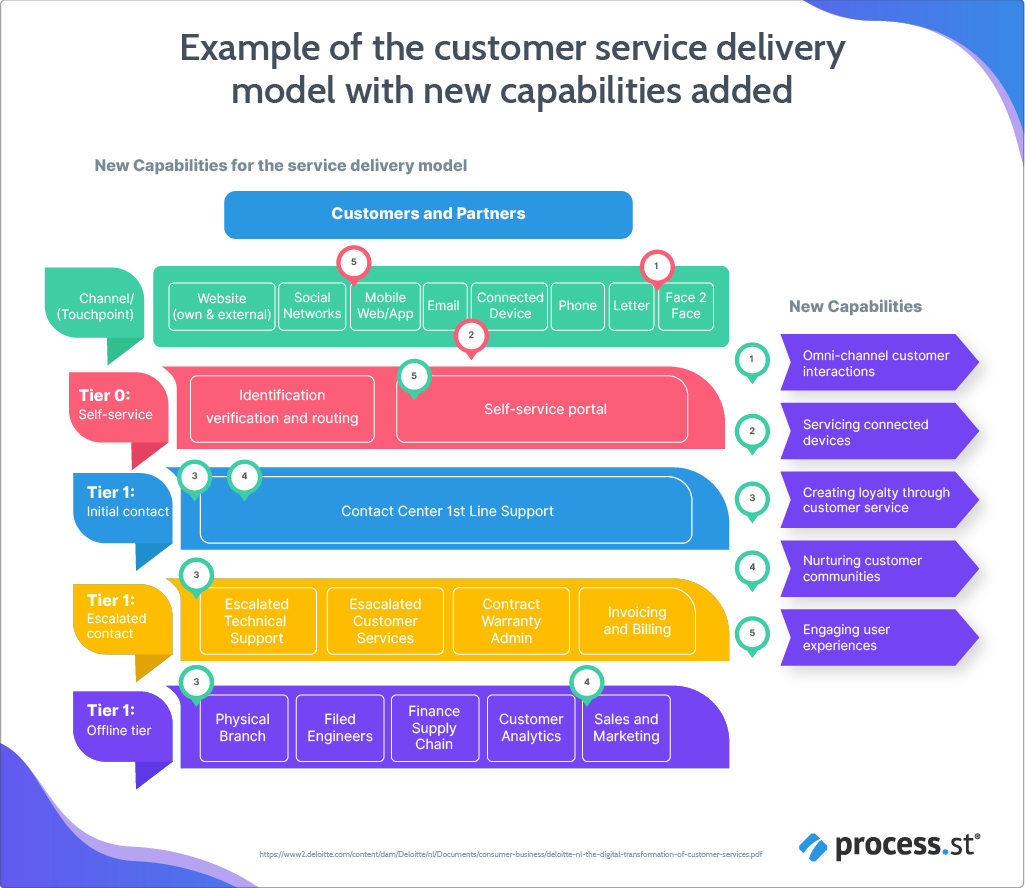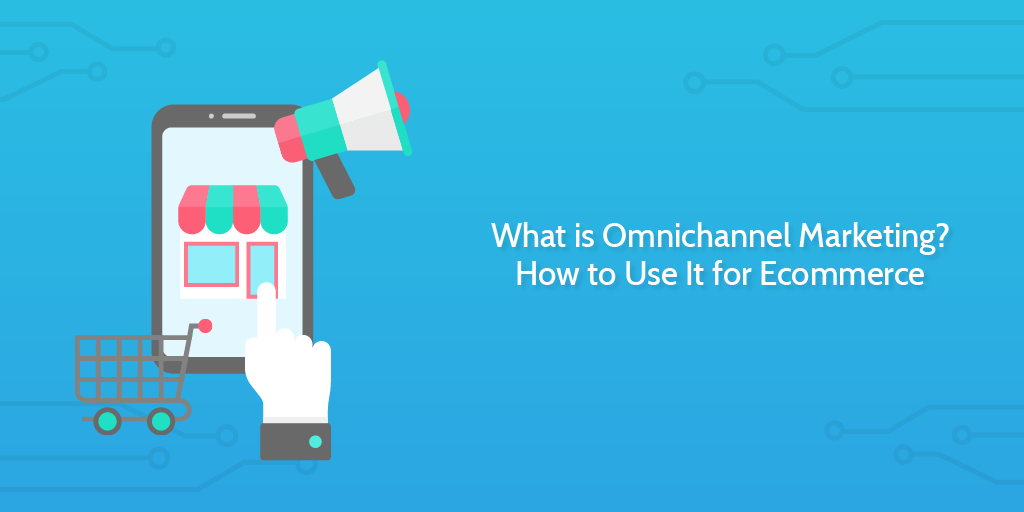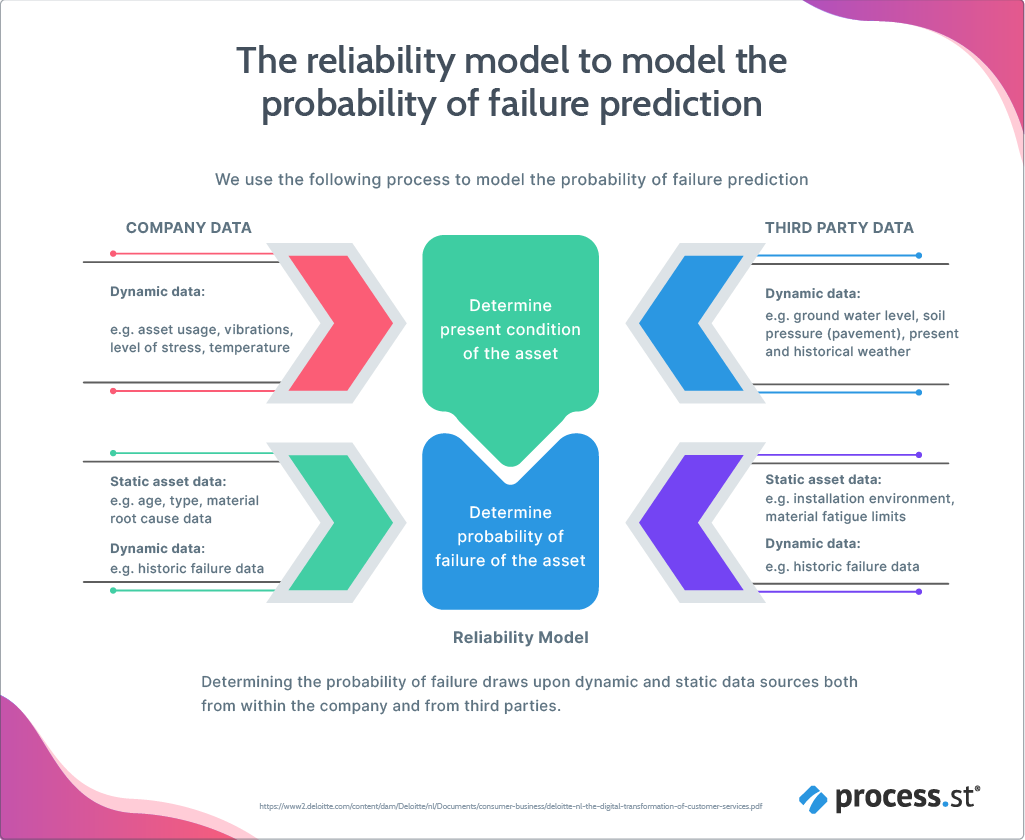
According to Bain & Company, a mere 5% increase in customer retention can equate to a profit boost of 25%. This is because repeat customers will spend more with your brand – 67% more to be exact.
Providing a top-notch customer service allows your business to recoup customer acquisition costs and cultivate a loyal following. Your customer service team is the heart of your organization and is your means of retaining and extracting value from your customers.
Like Bain & Company, we at Process Street think it’s vital to get your customer service operations right. And to do that, you need a refined and well-oiled CS delivery model. One that’s up to date with the times.
We turn our attention to The Digital Transformation of Customer Services report by Deloitte. We summarize the information from this report to present 5 actionable steps that’ll create Deloitte’s customer service delivery model. This model delivers effective customer service operations that mitigate today’s market disruptions.
Sounds good, eh?
With that said, let’s jump to it and get your customer service model right!
- The whirlwind of disruptive forces in today’s marketplace
- Reforming your customer service delivery model in five steps
Here’s to putting the success back in customer success!
The whirlwind of disruptive forces in today’s marketplace
We’ve spoken a lot about a digital transformation in customer success.
➡ Check out our top customer success posts here! ⬅
This transformation is demanding a customer success reformation; a reformation that’s driven by the customer. Websites, blogs, vlogs, podcasts, and social platforms are changing the customer’s buying journey. By the time your customers come to make a purchase, they know what they want to buy and the amount they want to pay.
Every customer success representative needs to be aware of the disruptive forces induced by technology. These forces include:
- The rapid adoption of technology : Businesses and customers are adopting technology on an exponential level. Major advancements include social networks, mobile computing, analytics, and cloud computing.
“The current pace of technological advance is unprecedented in history and shows no signs of stabilizing as other historical technological innovations, such as electricity, eventually did.” – Deloitte University Press, From Exponential Technologies to Exponential Innovation
- Changes in customer behavior : According to a report published by the Institute of Customer Service, customers today are facing significantly fewer problems when buying goods and services than they did 5 years ago. E.g. the percentage of customers experiencing a problem in 2008 was 17%. This percentage figure decreased to 11.7% in July 2012. This drop is more significant when you consider the number of customers making a complaint has risen from 72% to 76% in the same period.
- Increased competition ⚔: New competitors are flooding the markets and engaging with direct competition. Barriers to entry are lower due to de-regulation, globalization, and technological development.
These disruptive forces are acting together to create a sudden impact on the traditional markets.

Keeping these disruptive forces in mind, we at Process Street turned our attention to Deloitte’s The Digital Transformation of Customer Services report. This report has designed five important customer service capabilities:
- Omnichannel customer interactions
- Service connected devices
- Creating loyalty through customer service
- Nurture customer communities
- Create engaging user experiences
With these capabilities, Deloitte aims to adapt customer service operations to mitigate current market disruptions.
This article takes these capabilities and gives you five actionable steps to apply Deloitte’s advice. These steps will reform your customer service delivery model for your SaaS enterprise.
Reforming your customer service delivery model in five steps
A customer service delivery model is a concept that puts customer service operations into tiers. Below is an illustrative example of a customer service delivery model (note that the service delivery model is for illustrative purposes only, and does not apply to all industries).
Tier 1 operations receive initial contact. The aim is to identify, diagnose, and resolve the query. If this cannot be done, the query is moved onto the second tier made up of specialists.
Tier 3 operations are specialized and aim to resolve the query. If they cannot, then the query is sent onto the third tier of operations. The third tier is even more specialized…and on it goes.
An important tier in the digital world is Tier 0. This tier relies on automation and/or self-service functionality.

You’ve probably noticed the numbers in the image above. These represent a new Deloitte capability from capability one to five; or, as in this article, from steps one to five.
You see, rather than listing these capabilities, this Process Street article goes one step further. We’ll discuss how you can apply each to your customer service delivery model.
With that said, let’s jump straight to it!
Step #1: Omni-channel customer interactions
With omnichannel interactions, customers are using multiple channels, simultaneously, irrespective of time, place, device, or medium.

Omnichannel interactions add complexity to the customer’s journey. Organizations must first understand the entire customer journey to apply the right technology at the right time.
For instance, I was recently on the search for some new hiking poles. In my quest, I went to a new outdoor store that opened near where I live. Upon entering the store, I received a social media notification about new store discounts. Me being me, I was easily side-tracked and I found myself adding a new jacket, shorts, and cap into an online basket.
Before I hit checkout, I had a rethink. Did I need these items? I abandoned the cart and returned to my walking pole quest.
Later that week, I received emails enticing me back to complete my purchase, and my social media feed displayed advertisements from the brand.
This is a real-world example of omnichannel marketing.
I was sent a targeted advertisement by social media while interacting with the brand on a face-to-face level at the store. I then interacted with the brand via email and on my social media feed.
In this instance, my customer journey was understood, and the right technology was applied at the right time to build engagement. I didn’t receive another email notification when I hadn’t interacted with the first. Instead, marketing efforts were tailored back down to use social media solely. This action recognized that I was at the early stages of my journey with this brand.
To apply omnichannel interactions effectively, you must understand your customer’s journey. New channels should then be introduced when the customer is at the right level of maturity, early enough to deliver a competitive edge.
The omnichannel approach means customers can interact over the channels they want to use. These preferences may change depending on location, process, and time. This means you also need to segment your customers to better direct engagement and support efforts.
Action items:
- Map your customer journey.
- Define your target audience personas, segment your audience and identify their preferred channels of interaction.
For more information on how to achieve the above, read:
- Reach the Right People & Get the Right Result With a Customer Profile
- Upgrade the Customer Journey with User Experience Maps and Reduce Churn
Step #2: Service-connected devices
Servicing connected devices allows teams to monitor equipment remotely and analyze device data to predict possible failures.
For instance, for my Canon printer, I can monitor ink usage which gives me full transparency over the efficiency of my device. I do not doubt that this will save me money by instantaneously notifying me of a fault. Thinking on a B2B level, a Gartner report indicated that active management of printer and copier activity can save between 10-30% of print costs, with quick identification and understanding of failures.
In this instance, Canon utilizes technology allowing the customer to monitor their equipment and usage for self-service maintenance.
Now, compare this with more traditional forms of maintenance, where checks are performed periodically to decrease unexpected failures.
Technology means businesses can continuously monitor the performance of their product to avoid over-maintenance.
Collect data to determine the present condition of your asset. This could be internal or third-party data, each collected from the customer or other stakeholders.
Estimate the probability of asset failure using the company and third-party historical data sets. Combine this information with static data measures – for instance, product age, types, materials, etc.
Collecting this information creates a reliability model (as shown in the image below). This model predicts the probability of failure.

Use the reliability model along with root cause analysis to service your products using connected devices.
Action items:
- Complete a reliability model by collecting company and third-party static and dynamic data for your product(s).
- Complete a route-cause analysis for flagged issues.
To find out how you can perform a route cause analysis, read: How to Perform a Root Cause Analysis (Free Template).
Step #3: Creating loyalty through customer service
The focus for customer success teams globally is to drive customer loyalty.
The Institute of Customer Service published a report indicating that people-related issues – such as staff attitudes and competence – caused the majority of problems that elicited a complaint (62%). This was compared to complaints about the reliability of goods, which accounted for 34%.
The research suggests that customers are most satisfied when complaints are dealt with immediately. As a result, organizations need to ensure that all customer contacts are handled consistently well and that customers are not passed from pillar to post.” – Jo Causon, Poor staff attitude and competence most common causes for customer complaints
With this in mind, organizations need to change how they measure and reward customer success representatives.
Take the online clothing and shoe retail store, Zappos, as an example. A customer success representative’s performance is measured by the extent of the personal and emotional connection made. CS teams aim to address unstated customer needs. Zappos has grown to a $1.2 billion business using this unorthodox approach.
“Last year, when I was working the phones, a woman called, trying to return some boots. The sad story turned out to be that she had bought them for her father, who had since died. I told her not to bother returning them; that we would refund her money but she was free to give the boots away instead of returning them. And after the call, I felt moved to send her some flowers – just one of the 380 gifts of flowers you can see on the board that we sent out last year. Sometime after that, she sent me a letter and a photo of her father.” – Ryo Hanalei Zsun, Tony Hsieh Reveals The Secret To Zappos’ Customer Service Success In One Word
To maximize customer loyalty, you need a way of measuring the health of your accounts. Use our Account Health Scorecard Checklist Workflow to maximize account health and create loyal customers.
Click here to access our Account Health Scorecard Checklist Workflow today!
Key checklist features:
- File Upload and Approvals: You’ll be asked to upload the account scorecard you produce using our File Upload feature. Your manager is then notified that your scorecard is ready for assessment, and can jump in and accept/reject (with comments) as required using our Approvals feature. This gives an extra layer of quality control.
- Stop Tasks: Stop Tasks ensure the required steps for creating an accurate scorecard are completed in the correct order.
- Role Assignments: Use our Role Assignments feature to assign your supervisor to the approval task. Your supervisor will be automatically notified of the upcoming approval action required.
For more information on what Process Street is and how to use it, watch the below introductory video.
Action items:
- Focus on building customer loyalty by measuring the health of your accounts.
- Actively improve this health using our Account Health Scorecard Checklist Workflow.
Step #4: Nurture customer communities
A positive customer community will reduce call volume, generate greater customer insight, create compelling word-of-mouth marketing, and establish communication lines for improvement ideas.
Jumping straight into the action items, this is what you need to do to nurture a positive customer community for your business:
- Connect the outside to the inside: Establish strong employee-customer relationships by recruiting the right people to your CS team. Build robust security and privacy processes using Process Street as your no-code process documentation tool. To learn how to perfect your employee onboarding process, read: 6 Checklists to Perfect your New Employee Onboarding Process.
- Establish consistency across forums: Your customers will move from one forum to another. Therefore, consistency in business communications is critical. Document best practices and language while removing guesswork and human error using Process Street. Learn how Salesforce uses Process Street to build the consistency needed in their operations.
- Use branded forums first: Lead conversations on your forums first to give you control of user-generated content.
- Incentivize users to comment: Incentivize your customers to comment. This could be by including a reward system, or through the use of gamification techniques.
Step #5: Create engaging user experiences
Cutting-edge technology from the likes of Apple, Google, and, of course, Process Street , have led consumers to expect a digital service that is clean, simple, and user-friendly. And online channels play a critical role in establishing perceptions and an overall brand image.
You need to employ lean and agile development in your business. Find out how we keep operations agile at Process Street by reading: The 11 Agile Processes We Use to Run an Efficient Software Team.
Plus, why not have a browse through more of our top content to understand how you can create a lean, agile, business machine:
- Kanban vs Scrum: Understanding the Tools for Agile Success
- Waterfall vs Agile: Which Methodology Is Right For You?
- 7 Software Development Processes to Engineer Your Success
- What is Fake Agile? Understanding the Dark Side of Agile and How to Avoid It
- Become a Lean Machine With These Top 8 Lean Tools (Free Templates)
Next, establish consistency. Processes run at the heart of your business. Every business output has a process associated. By documenting these processes, you gain full transparency over work done by your teams and departments. Gain consistency with Process Street by documenting your best practices so team members will perform all tasks as required.
Finally, use A/B testing to try out multiple variations of a concept. Collect analytical data and go with the digital technological design proven to work.
Action items:
- Apply lean and agile development methodologies.
- Build consistency by documenting your business processes.
- Continuously monitor and test new ideas using A/B testing.
Adapt to the breakneck speed of technological development using Deloitte’s customer service delivery model
Customer success leaders must embrace continuous development, and actively seek out new opportunities. With this in mind, technological development can either be a disruption or a new opportunity.
By completing the five steps given in this article, your customer success team can respond to the market disruptions appropriately, something you can use to give you a competitive advantage.
How have you transformed your customer service operations in response to the market disruptions present today? What successes and challenges have you faced? We’d love to hear from you in the comments below!!







 Workflows
Workflows Projects
Projects Data Sets
Data Sets Forms
Forms Pages
Pages Automations
Automations Analytics
Analytics Apps
Apps Integrations
Integrations
 Property management
Property management
 Human resources
Human resources
 Customer management
Customer management
 Information technology
Information technology



Jane Courtnell
Hi there, I am a Junior Content Writer at Process Street. I graduated in Biology, specializing in Environmental Science at Imperial College London. During my degree, I developed an enthusiasm for writing to communicate environmental issues. I continued my studies at Imperial College's Business School, and with this, my writing progressed looking at sustainability in a business sense. When I am not writing I enjoy being in the mountains, running and rock climbing. Follow me at @JaneCourtnell.